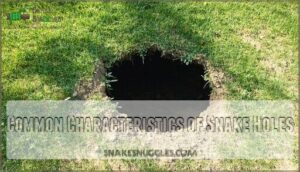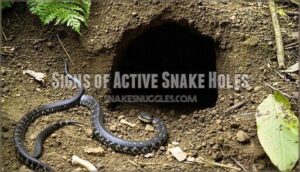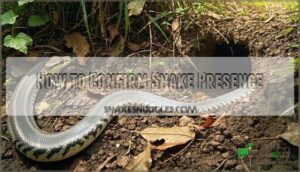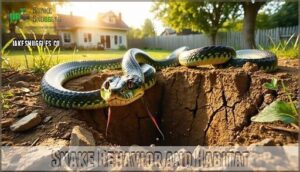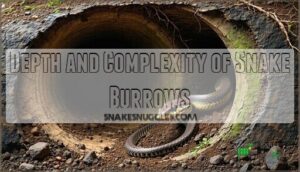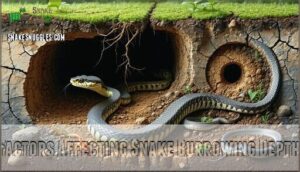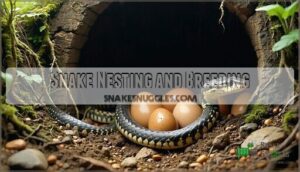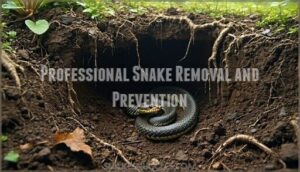This site is supported by our readers. We may earn a commission, at no cost to you, if you purchase through links.
 If you’re curious about how snakes dig holes underground, here’s the scoop: most snakes don’t actually do the digging.
If you’re curious about how snakes dig holes underground, here’s the scoop: most snakes don’t actually do the digging.
Instead, you’ll catch them slithering into holes that other animals, like rodents or insects, have left behind. Snakes use these ready-made tunnels as their own underground hideaways, escaping predators, heat, and cold.
Their bodies are smooth and flexible, perfect for slipping into tight spaces, but they rarely have the claws or strength needed for serious excavation. So, those mysterious snake holes you spot in the backyard probably weren’t dug by snakes at all—just borrowed.
Now, let’s uncover what really attracts them to these underground locations, and understand the role of underground hideaways in their behavior.
Table Of Contents
- Key Takeaways
- Identifying Snake Holes
- Snake Behavior and Habitat
- Snake Retreats and Hiding Places
- Dealing With Snake Holes and Infestations
- Snake Hole Characteristics and Depth
- Snake Nesting and Breeding
- Professional Snake Removal and Prevention
- Frequently Asked Questions (FAQs)
- How do snakes dig holes?
- Why do snakes burrow underground?
- How do you know if a snake is digging a hole?
- Do snakes burrow in holes?
- Can snakes be dangerous when they dig holes?
- Do snakes dig their own homes?
- How do snakes dig holes in the ground?
- How do you tell if a hole is from a snake?
- What do snake nests look like?
- How deep do snakes go underground?
- Conclusion
Key Takeaways
- You’ll find that most snakes don’t actually dig their own holes – they’re smart opportunists who move into burrows already made by rodents, insects, or other animals, saving energy while getting perfect shelter.
- You can identify snake holes by looking for clean, circular entrances 2-4 inches wide with no debris, spider webs, or leaves around the opening, plus signs like shed skin or droppings nearby.
- Snakes use these underground hideaways for multiple survival needs including escaping predators, regulating body temperature, ambushing prey, and protecting themselves during digestion or egg-laying.
- If you discover snake holes on your property, don’t investigate them yourself – maintain safe distances, wear protective gear if you must examine the area, and contact professional wildlife control for safe identification and removal.
Identifying Snake Holes
You can spot snake holes by looking for clean, circular entrances about 2-4 inches wide that lack debris, spider webs, or leaves around the opening.
Look for neat, round holes 2-4 inches wide with no leaves or webs—these are classic signs of a snake’s entrance.
Fresh snake tracks, shed skin, or droppings near the hole confirm active use by these reptiles.
Common Characteristics of Snake Holes
Snake holes display distinctive characteristics that make identification straightforward.
These underground tunnels typically feature circular entrances measuring 2-4 inches in diameter, though hole size varies by species. The entrance shape remains consistently round and smooth.
Key identifying features include:
- Cleanliness – Entrances lack debris, leaves, or spider webs
- Location factors – Found in grassy areas with small dirt mounds nearby
- Depth variations – Usually shallow, just a few inches deep
- Smooth edges – Clean, well-defined circular openings
- Multiple clusters – Often appear in groups within suitable snake habitat
These snake burrowing sites maintain their neat appearance because snakes regularly use them for shelter and hunting.
Signs of Active Snake Holes
Wondering how to spot an active snake hole? Look for fresh tracks in loose soil around the entrance, indicating recent activity.
Check for skins shed nearby, dark faeces presence with white streaks, and prey remains like small bones.
Active underground tunnels show clear, debris-free openings that reveal ongoing snake burrowing behavior in their chosen snake habitat.
How to Confirm Snake Presence
Confirming snake presence requires detective work beyond spotting holes.
Look for shed skins near entrances—these papery casings reveal recent activity. Fecal matter appears tubular with white streaks, indicating digestive waste.
Track patterns in soft soil show serpentine movement. Listen for subtle snake sounds like rustling through vegetation.
Visual confirmation remains the gold standard—observe from a safe distance during dawn or dusk when snakes are most active.
Importance of Professional Inspection
Once you’ve spotted potential snake activity signs, professional wildlife control becomes your best bet for accurate assessment and safe handling.
Trust the experts for safe snake removal and peace of mind around your home.
Certified experts provide expert identification of snake species, guaranteeing legal compliance with local wildlife laws. They’ll conduct thorough evaluations of snake hole identification markers and snake activity signs around your property.
Professional services offer thorough solutions that go beyond simple removal:
- Safe removal techniques that protect both you and the snake from harm
- Accurate assessment of snake digging patterns and snake burrowing behavior
- Legal compliance with wildlife protection regulations in your area
- Long-term prevention strategies customized to your specific property needs
- Follow-up monitoring to guarantee snakes don’t return to the same locations.
Expert identification prevents dangerous encounters with venomous species while guaranteeing non-threatening snakes receive proper relocation rather than unnecessary elimination.
Proper assessment requires snake hole inspection tools.
Snake Behavior and Habitat
You’ll discover that snakes have fascinating behaviors regarding finding shelter and establishing their territory in your backyard.
Understanding their burrowing capabilities and habitat preferences helps explain why certain species might take up residence near your home, which can be related to their need for shelter.
Types of Snakes Found in Backyards
Your backyard might host various snake species, both helpful and potentially dangerous.
Common non-venomous types include garter snakes, northern water snakes, and black rat snakes that control rodent populations.
However, venomous species like water moccasins and eastern coral snakes also inhabit residential areas, making proper snake identification tips essential for safety.
Suburban residents report increased snake sightings during warmer months.
Venomous or Non-Venomous Snake Type
Snake Burrowing Capabilities
Most snakes can’t dig their own holes, but some species have impressive snake burrowing adaptations.
These burrowing snakes like sand boas use powerful muscles for soil excavation through loose substrates:
- Hognose snakes rock side-to-side with upturned snouts
- Sand boas push through sandy soil using body undulation
- Pine snakes spend hours spading dirt with their heads
These snake digging techniques provide burrowing benefits including temperature control and predator protection.
Purpose of Snake Holes
Snake holes serve multiple critical functions that guarantee survival.
These underground retreats offer Predator Protection from threats like birds of prey and larger mammals.
They’re also strategic Prey Ambush points where snakes wait for unsuspecting rodents.
Temperature Regulation keeps snakes comfortable during extreme weather, while providing secure spots for Safe Digestion after meals and Egg Laying for reproductive success.
Snake Home Ranges and Shelter
Unlike many animals that establish defined territories, snakes don’t claim specific home ranges. They’re opportunistic about shelter selection, using whatever protection is available nearby.
You’ll find them in burrows made by other animals, hollow trees, rock crevices, or dense vegetation.
Fossorial snakes show stronger burrow fidelity, returning to the same underground retreats.
Habitat overlap is common since multiple species compete for prime shelter spots, creating resource competition in areas with limited hiding places.
Snake Retreats and Hiding Places
You’ll find that snakes don’t actually dig most holes themselves – they’re smart enough to use existing burrows made by other animals.
When snakes do need shelter, they’ll seek out pre-made retreats like rodent holes, tree hollows, rock crevices, and leaf litter piles that provide the perfect snug fit they crave for security.
Pre-Existing Holes Used by Snakes
Most snakes practice Rodent Burrow Takeover, claiming abandoned holes from mice, gophers, and ground squirrels rather than digging their own.
Turtle Burrow Havens offer spacious underground retreats, while frog holes provide moisture and prey access.
This Hole Competition among Species Preferences creates efficient Burrow Benefits – ready-made shelter saves energy while offering temperature control, protection, and hunting opportunities from existing animal burrows.
Tree Hollows and Bark as Snake Hides
Higher elevations offer snakes excellent hiding spots beyond ground-level burrows. Black rat snakes expertly climb into tree holes, while scarlet kingsnakes slip beneath loose bark for perfect bark camouflage.
These arboreal snakes select retreats based on specific needs:
- Hollow size must accommodate the snake’s body snugly
- Tree species preferences vary by snake type
- Temperature regulation benefits from elevated positions
- Bark thickness provides insulation and concealment
- Dead trees offer softer, more accessible reptile habitat
Understanding snake behavior helps identify potential animal burrows and reptile behavior patterns in your yard.
Rocks, Logs, and Leaf Litter as Snake Hides
Beyond tree hollows, you’ll discover snakes seeking refuge in diverse ground-level hideouts.
Rock thermal properties create perfect temperature zones, while different log decay stages offer varying microclimate variations. Leaf litter depth provides excellent camouflage effectiveness for reptile concealment.
These natural features support essential snake behavior patterns and reptile habitat requirements. Snakes require secure spaces, and safe snake hides are essential for reducing stress.
Key snake hiding spots you might encounter:
- Rock crevices – Stone formations trap heat during day, release warmth at night
- Rotting logs – Decomposing wood creates humid microclimates snakes love
- Deep leaf piles – Multiple litter layers offer concealment and insulation
- Boulder clusters – Natural rock formations provide secure, temperature-stable retreats
Snake Preference for Snug Retreats
Most snakes can’t create their own burrows, so they depend on finding the perfect snug hole size for security considerations.
These species-specific needs drive their snake habitat preferences toward tight retreats where their backs touch the ceiling.
This burrow design provides temperature regulation and safety, whether it’s retreat materials like tree bark or existing tunnel construction from other animals.
Snakes prioritize hole size that offers maximum protection during the snake burrowing process.
Dealing With Snake Holes and Infestations
Finding snake holes on your property can be concerning, but knowing how to handle them safely protects both you and your family.
You’ll need to take proper precautions when investigating these burrows and implement effective strategies to discourage snakes from making your yard their permanent home, which involves understanding how to safely interact with snake holes.
Safety Precautions for Examining Snake Holes
Understanding where snakes might be hiding becomes meaningless if you can’t safely investigate those areas.
Snake hole safety requires careful preparation and smart decision-making to avoid bites and protect yourself and your pets.
Here are four essential safety measures for examining potential snake holes:
- Wear protective gear: Long pants, closed-toe boots, and thick gloves provide barriers against snake bites.
- Maintain safe distances: Never stick hands, feet, or tools directly into holes.
- Tool usage matters: Long-handled tools like mirrors or cameras can help you examine holes without getting close.
- Professional help saves lives: Wildlife experts have proper equipment and training for snake hole professionals situations.
They understand snake safety protocols and can identify venomous species quickly.
Pet safety requires keeping dogs and cats away from suspected snake holes entirely.
Use a flashlight from several feet away to peer inside, keeping your body positioned for quick retreat.
Avoid using sticks or short implements that require proximity.
Your skin shouldn’t be exposed when investigating unknown holes.
Discouraging Snakes From Nesting
Beyond basic deterrence, habitat modification proves most effective for snake hole prevention. Remove debris piles, tall grass, and food sources like rodents to eliminate attractions.
Install exclusion barriers around foundations using mesh or hardware cloth. Natural deterrent methods include sulfur-based snake repellent around vulnerable areas.
Maintain short vegetation for better visibility and snake safety.
| Method | Effectiveness |
|---|---|
| Remove food sources | High – eliminates snake prey |
| Clear debris piles | High – reduces shelter options |
| Install mesh barriers | Medium – blocks entry points |
| Apply natural repellents | Low – temporary repellent effectiveness |
| Maintain short grass | Medium – improves detection |
Filling Vacant Snake Holes
Once you’ve confirmed snake disappearance, filling vacant underground holes prevents future animal control issues.
Pack dirt or soil firmly into the opening, creating a barrier against collapse.
Here’s your step-by-step approach:
- Material Choices: Use native soil mixed with clay for durability and natural refills that blend seamlessly. Consider using a specialized clay soil for ideal results.
- Human Intervention: Tamp down layers gradually, ensuring no air pockets remain beneath the surface.
- Preventing Collapse: Add small stones at the bottom for structural support in deeper snake habitat areas.
- Legal Considerations: Check local regulations before altering wildlife areas, as some snake behavior patterns require protected spaces.
Eliminating Hiding Places and Food Sources
Why wait for snakes to establish their snake habitat when you can prevent it?
Reduce clutter around your property and control rodents that form their primary snake diet. Limit water sources, secure compost bins, and manage vegetation by trimming overgrown areas.
These steps eliminate attractions that draw snakes while supporting natural snake predators, making your yard less appealing for snake identification concerns and reducing need for animal control services.
Consider adding rock piles for shelter to encourage snakes to inhabit areas away from your home, which can help in creating a snake-friendly environment.
Snake Hole Characteristics and Depth
You’ll notice that snake holes are usually clean, round, and just big enough for the snake to squeeze through, with entrances often surrounded by loose dirt.
Most snake burrows aren’t very deep, typically reaching only a few inches below the surface, which keeps the snake close to prey and shelter.
Entrance and Exit Points of Snake Holes
Spotting snake holes takes a sharp eye. You’ll notice that Hole Size and Entrance Shape vary based on snake digging abilities and soil composition.
Look for clean entrance points, often narrow holes, blending right into the landscape. Camouflage Techniques keep entrances hidden, while Multiple Entrances offer escape routes.
Here’s what to watch for:
- Entrances tucked behind rocks or logs
- Tiny exit points, coin-sized
- Fake entrances for predator confusion
- Signs of snake presence nearby, utilizing Multiple Entrances for escape routes.
Depth and Complexity of Snake Burrows
From shallow hideouts to deep, winding tunnel systems, snake burrowing shows surprising variety.
Burrow depth often stays under one meter, but tunnel complexity can include multiple chambers for resting and hiding. Chamber size matches the snake’s body, ensuring soil stability and safety.
Whether for shelter or hunting, each burrow’s purpose depends on the snake’s digging abilities and soil composition.
These holes typically measure 2 to 6 inches in diameter.
Some snakes, however, simply utilize existing burrows created by other animals.
Factors Affecting Snake Burrowing Depth
When you’re thinking about how deep a snake digs, several factors matter.
Soil type and composition can make burrowing easy or tough. Snake size and physiology also shape tunnel depth, with larger snakes needing wider, sturdier spaces.
Climate impact and predator avoidance push snakes deeper when conditions demand.
Here are three key influences:
- Soil Type and Composition
- Snake Size and Physiology
- Climate Impact and Predator Avoidance
Snake Nesting and Breeding
You’ll notice snakes choose underground holes for nesting and breeding because these spots offer protection from predators and harsh weather.
In these secure environments, snakes lay eggs or give birth, ensuring their young have the best chance of survival.
Snake Nesting Behavior and Habitat
A snake’s nesting behavior depends on habitat and species.
You’ll find garter snakes nesting together under rocks or logs, while northern water snakes prefer solitary burrows near water.
Black rat snakes often share tree hollows, and ringneck snakes settle in leaf litter.
Nest Site Selection is driven by security and the right Nesting Materials.
Egg Deposition and Clutch Size vary, but snake adaptations guarantee hatchling care.
Burrowing and snake habitat use help snakes thrive in the underground ecosystem.
Some species exhibit nest-site philopatry, with females returning to their maternal capture sites for nesting.
Characteristics of Snake Nests
You’ll notice snake nests come in all shapes and sizes, from simple burrows to complex tunnel networks.
Here’s what sets them apart:
- Nest Materials: Leaves, grass, and soil create comfort.
- Egg Deposition: Smooth spaces for eggs.
- Nest Temperature: Insulated for safety.
- Nest Defense: Hidden entrances deter predators.
- Nest Location: Strategic placement guarantees survival.
Snake Breeding and Reproduction
After learning about nest traits, you might wonder how snake reproduction actually works.
During Mating Rituals, females can store sperm from several males, deciding when to start their reproductive cycles.
Egg laying follows, with clutches ranging from 2 to 100 snake eggs depending on species.
The Incubation Period lasts 30-90 days, and then snake hatchlings emerge.
Hatchling Care is mostly independent, as most snakes don’t stick around.
About 50-70% of hatchlings survive.
Here’s a quick look:
| Stage | Key Details |
|---|---|
| Mating Rituals | Sperm storage, selection |
| Egg Laying | 2-100 eggs per clutch |
| Incubation | 30-90 days |
| Hatchling Care | Mostly independent |
| Survival Rate | 50-70% |
Professional Snake Removal and Prevention
If you find snakes using holes around your property, it’s important to contact professional wildlife control for safe removal and prevention.
You’ll need to seal gaps, remove hiding places, and clear debris to reduce future infestations.
Expert Snake Removal Services
If you spot signs of snake digging or snake dens, don’t play hero—call expert snake removal services.
They specialize in safe relocation, humane trapping, and emergency removal.
With thorough property inspection and snake identification, professionals handle snake habitats and snake concealment, making sure your home stays safe.
Trust their expertise to keep snakes away, following all local regulations.
Preventing Future Snake Infestations
If you want to keep future snake guests from moving in, focus on prevention. Snakes are clever at finding gaps, so Seal Entryways around your house and shed. Yard Maintenance is key—keep grass short and remove clutter.
Repellent Use, like ultrasonic devices or certain plants, can help deter most snake species. Understanding snake ecology and movement patterns helps you stay one step ahead.
To effectively prevent snake invasions, consider the following steps:
- Seal entryways around your home
- Maintain tidy, clutter-free yards
- Use ultrasonic or plant-based repellents
- Encourage natural predators
- Consult professionals for persistent issues
Importance of Sealing Gaps and Removing Hiding Places
A handful of simple steps can make a big difference in snake protection.
Seal Entry Points around your home to Limit Access.
Eliminate Shelters by clearing debris and trimming vegetation—this reduces Attractants and supports snake habitat loss.
Maintain Property cleanliness to discourage snake ecology.
Effective exclusion tactics are essential for long-term prevention.
Snake-proof fencing adds another layer of safety, minimizing snakehuman interaction and protecting your space from potential snake threats.
Frequently Asked Questions (FAQs)
How do snakes dig holes?
Snakes don’t dig like moles; instead, you’ll see them push through loose soil or sand using their muscular bodies and snouts.
Some, like hognose snakes, have special upturned snouts, making tunneling through soft dirt much easier.
Why do snakes burrow underground?
You’ll find snakes burrow underground to escape predators, regulate body temperature, hunt prey, and lay eggs.
Underground shelters help them survive harsh weather, digest meals in peace, and even brumate, which is their version of hibernation.
How do you know if a snake is digging a hole?
If you spot a pristine, round hole with no debris, maybe some snake skin or droppings nearby, and see dirt on a snake’s scales, chances are you’ve caught a snake in the act of digging underground.
Do snakes burrow in holes?
You’ll notice snakes often burrow in holes, but most don’t dig their own.
They prefer repurposing rodent or turtle burrows, using these underground spaces for shelter, hunting, brumation, and protection from predators and harsh weather.
Can snakes be dangerous when they dig holes?
Ever thought a hole could double as a snake’s secret lair?
You’d be wise to keep your hands and pets clear, since some snakes bite defensively, especially if startled or protecting eggs inside their burrow.
Do snakes dig their own homes?
You won’t see most snakes digging their own homes; they usually move into holes made by rodents or other animals.
Only a few, like hognose snakes, can dig, thanks to special snouts and muscle power.
How do snakes dig holes in the ground?
When push comes to shove, snakes use their snouts and muscular bodies to wiggle through loose soil or sand, creating shallow depressions.
Most can’t dig deep, relying on existing burrows or soft substrates for shelter and hunting.
How do you tell if a hole is from a snake?
If you spot a clean, narrow hole with no spider webs or debris at the entrance, and maybe a shed snakeskin or droppings nearby,
you’re likely looking at a snake’s hideout rather than another animal’s burrow.
What do snake nests look like?
Imagine this mystery: snakes don’t actually build traditional nests like birds.
Most species simply deposit eggs in existing burrows, rotting logs, or leaf piles, then abandon them.
You’ll find clutches in warm, humid spots, which can be considered a key factor in their survival.
How deep do snakes go underground?
You’ll typically find snakes underground at shallow depths, usually just a few inches below the surface. Most species stay close to their food sources and don’t venture deep underground.
Conclusion
Understanding how snakes dig holes underground reveals nature’s clever recycling system at work.
You’ve discovered that snakes are opportunistic tenants rather than industrious excavators, preferring to inhabit burrows crafted by other creatures.
By recognizing the signs of snake activity, implementing proper prevention measures, and maintaining your property thoughtfully, you can coexist peacefully with these beneficial predators.
Remember, most snakes you’ll encounter are harmless allies in controlling pest populations around your home, and by doing so, you support a balanced ecosystem with nature’s clever solutions.
- https://pmc.ncbi.nlm.nih.gov/articles/PMC4681343/
- https://www.herpconbio.org/Volume_18/Issue_2/Bolt_etal_2023.pdf
- https://mynatureguard.com/blog/what-does-a-snake-hole-look-like-in-a-yard/
- https://blogs.uakron.edu/astleylab/wp-content/uploads/sites/1471/2024/02/Tingle-et-al-2024-Review.pdf
- https://journals.biologists.com/jeb/article/218/15/2416/14227/Morphology-and-burrowing-energetics-of-semi

